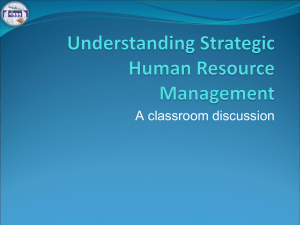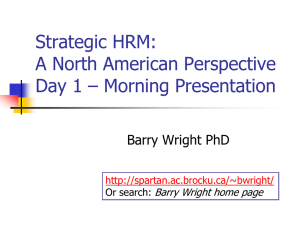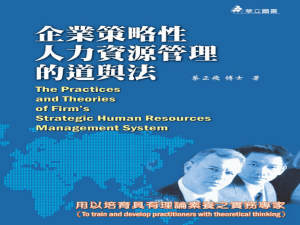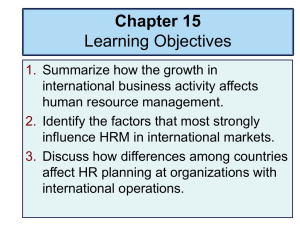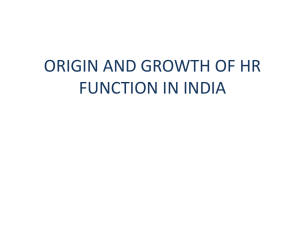How SHRM can contribute in achieving competitive advantage?
advertisement
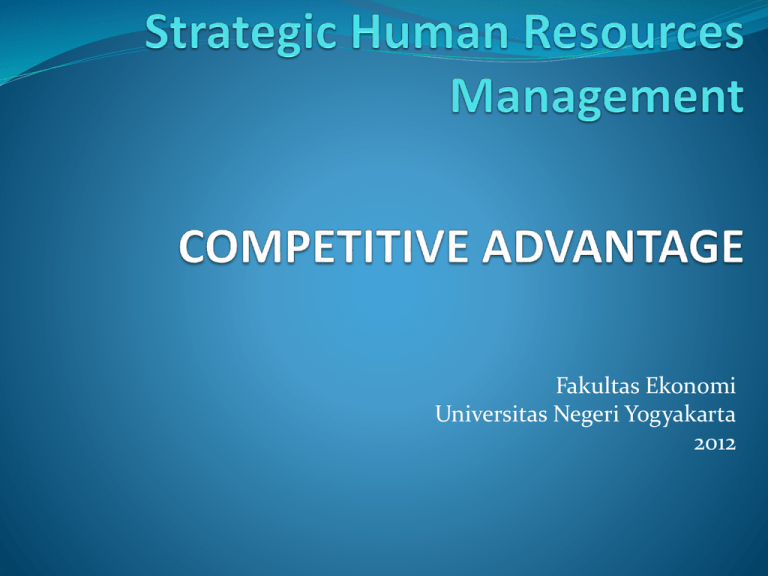
Fakultas Ekonomi Universitas Negeri Yogyakarta 2012 Introduction Strategy is an ambiguous term. Johnson and Scholes define strategy as the direction and scope of organizations over the long-term within a challenging environment whereby through the configuration of resources the needs of the markets are met and the stakeholders’ expectations are fulfilled in order to achieve an advantage. Nonetheless, strategy is applied unique to each levels of the organizations such as corporate, business unit and operational. Currently, the term ‘strategy’ is associated with every function of the organizations that purports on turning strategies into actions as a key to achieve cost and competitive advantages. Notable is the Strategic Human Resource Management (or simply SHRM). Introduction What is SHRM? The interest of numerous organizations in ‘strategic management’ resulted in the integration of organizationsal functions into strategic management processes. Human Resource Management (HRM) field likewise sought to integrate this strategic management schema through the development of a new discipline known as SHRM. As an outgrowth of its mother discipline, theorists and practitioners regarded SHRM as the reconciliation of HR practices and its determinants from a strategic context. However, the deficiency is that there is no strong theoretical model for HR determinants and the non-existence of clear delineation of SHRM with HRM. How SHRM can contribute in achieving competitive advantage? Nonetheless, despite universalistic, contingency or configurational approaches, SHRM is an important element of achieving the competitive edge in terms of quality, cost and flexibility. Either processual or systemic, SHRM puts human at the center. When we say ‘human’, it does not necessarily mean the employees, but embracing also those people whom the organizations does business with. Through them, sustainable competitive advantage, or the achievement of value-creating strategies that direct and indirect rivals could not implement, could be achieved. How SHRM can contribute in achieving competitive advantage? From a resource-based perspective, there are various categories of resources that SHRM can build upon to gain the so-called advantage such as physical, organizationsal, financial, and technological and most especially human resources. As assets, the mere existence of human is not sufficient but the relationship among them that therefore must be controlled for the purpose of long-term commercial success. The sustainable competitive advantage potential of human resources is central on the premises that human resources are valuable, rare, inimitable and non-substitutable. How SHRM can contribute in achieving competitive advantage? As valuable resources, human resources are heterogeneous since organizations require different jobs which require different skills as well as differing in types and level of idiosyncratic skills. As such, the variance placed on the contribution of individuals to the organizations means to provide value at diverse degrees. The rarity of high quality and ability workers is due to their skills and competency levels and the supposedly normal distribution of skills, competencies, expertise and capabilities. For the human asset to be imitated, competitors should be able to identify the exact source of such and duplicate exactly the elements of the human capital. In addition, human resources should not be imperfectly mobile so that they cannot be traded. Lastly, for the human resources to be able to provide sustainable competitive advantage, they must not be substitutable. How SHRM can contribute in achieving competitive advantage? Achieving competitive advantage is based on the collective practices within that are intended for the outside environment which otherwise cannot be achieved or limited through HRM alone. These are employment security, recruitment selectivity, high wages, incentive pay, employee ownership, information sharing, participation and empowerment, self-managed teams, training and skills development, cross-utilization and cross-training symbolic egalitarianism, wage compression and promotion from within. The emphasis is on envisioning individual workers as sources of competitive advantage instead of complementary or limiting factor of the organizational success. How SHRM can contribute in achieving competitive advantage? Competitive advantage is also realized when the organizations through SHRM is continuously investing on its reputation or image stressing the need for sound human resource policies and practices and aligning such with the business strategies and its external context. The focus is both on cost and quality whereby there are definite processes, systems and procedures that consolidates competencies, continuous education, proficient performance at individual and collegial levels and balance monetary and non-monetary reward systems. How SHRM can contribute in achieving competitive advantage? Apart from this, the materialization of the competitive advantage is delivered by investing on diversity and maximising their potential through SHRM. The things to consider are retention/turnover and motivation, morale and productivity, innovation, creativity and problemsolving, teamworking, ensuring synergy at all levels and avoidance of legal suits. It is also through SHRM that the creation of an inclusive workforce is plausible since there are structured opportunities for sharing and selfdisclosure, increased understanding of the cultural diversity, demonstrated flexibility for varying needs and preferences, demonstrated unwritten rules and mutuallysatisfying conflict resolution systems. Why not HRM alone? HRM that are too centered on human as an integral asset while neglecting the key factor of nurturing relationships with them and between them makes HRM a shallow endeavor though it is not to say that HRM is futile. With HRM, relationships stagnate whereas with SHRM relationships are optimized and translated into loyalty, engagement, trust and confidence among others. SHRM, unlike HRM which is confined as a mere organizationsal function, is tended on ‘above and beyond’ behaviours. Though HRM is in charge of relationship with employees at the business level, SHRM is responsible for the total stakeholder relationship strategy. Why not HRM alone? HRM cannot be considered doing so since there are still inconsistencies of defining what actually constitutes the best HR practices per se much more taking on a holistic approach to managing people and managing relationships between these people. There are also no clear evidences that HRM practices lead to improved organizationsal performance apart from difficult in justifying costs devoted to HR practices. Further, HRM are aligned only to specific organizationsal context such as the needs of the employees, its contradicting ideologies, the inadequacy of HRM systems and lack of synergy between HR practices. Achieving competitive advantage through strategic human resource management. Fottler MD, Phillips RL, Blair JD, Duran CA. The framework presented how manage human resources strategically as an integral part of the strategic planning process. Executives should consciously formulate human resource strategies and practices that are linked to and reinforce the broader strategic posture of the organization. The framework consist (1) determining and focusing on desired strategic outcomes, (2) identifying and implementing essential human resource management actions, and (3) maintaining or enhancing competitive advantage. Achieving competitive advantage through strategic human resource management. The strategic approach to human resource management includes: assessing the organization's environment and mission; formulating the organization's business strategy; assessing the human resources requirements based on the intended strategy; comparing the current inventory of human resources in terms of numbers, characteristics, and human resource management practices with respect to the strategic requirements of the organization and its services or product lines; formulating the human resource strategy based on the differences between the assessed requirements and the current inventory; and implementing the appropriate human resource practices to reinforce the strategy and attain competitive advantage. The resource-based view of competitive advantage Hamish G. H. Elliott Over the last twenty years, protagonists of the resourcebased view of competitive advantage have produced an increasing amount of empirical research substantiating their espoused theories that the resources and capabilities of the firm are the foundation for its long-term strategy because of two premises. First, internal resources and capabilities are viewed as the key competitive sources of a firm’s strategy; and secondly, the majority of the firm’s superior returns are derived from these (Barney, 1991; Chamberlin, 1962; Collis, 1991, 1994; Collis & Montgomery, 1995; Conner & Prahalad, 1996; Grant, 1991; Peteraf, 1993). The resource-based view of competitive advantage ……Hamish G. H. Elliott The resource-based view defines competitive advantage as when a firm is implementing a value creating strategy not simultaneously being implemented by any current or otential competitors (Barney, 1991). This assumes a firm’s competition includes all current competitors, but also, potential competitors. Within this definition, a firm can create short run competitive advantage or first-mover advantage (Barney, 1991). However, it is not sustainable because other competitors may be able to imitate or purchase the sources of the advantage (Amit & Schoemaker, 1993; Barney, 1991; Collis & Montgomery, 1995). The resource-based view of competitive advantage Hamish G. H. Elliott Sustained competitive advantage is achieved when a firm is implementing a value creating strategy not simultaneously being implemented by any current or potential competitors and when these other firms are imperfectly able to imitate the benefits of this strategy (Barney, 1991). Firm resources are defined as including “all assets, capabilities, organizational processes, firm attributes, information, knowledge, etc. controlled by a firm that enable it to conceive of and implement strategies that improve its efficiency and effectiveness” (Daft, 1983, cited in Barney, 1991, p. 101). These are categorised as physical capital resources, human capital resources, organizationsal capital resources (Becker, 1964, Williamson, 1975, Tomer, 1987, cited in Barney, 1991), and financial resources, technological resources, and reputation (Amit & Schoemaker, 1993; Grant, 1991). The resource-based view of competitive advantage …..Hamish G. H. Elliott To sustain competitive advantage from a firm’s idiosyncratic resources, Dierickx & Cool (1989) propose the notion of asset stock accumulation. They argue that if resources are freely available on an open strategic factor market, as proposed by Barney (1986b), then anyone can attain the resource and potentially use it to achieve the same/or better results, unless the resource is limited by supply. Conversely, a more favourable approach to sustainable competitive advantage is the use of intangible (or tacit) resources that are generally built rather than bought (Dierickx & Cool, 1989). The resource-based view of competitive advantage Hamish G. H. Elliott Strategic assets are the cumulative result of adhering to a set of consistent policies over a period of time, that is, strategic asset stocks are accumulated by choosing appropriate time paths of flows over a period of time (Dierickx & Cool, 1989; Hall, 1992, 1993). For example, a reputation for quality may be built (rather than bought) by following a consistent set of production, quality control etc. policies over some period of time (Dierickx & Cool, 1989). It is proposed that human resources are a strategic asset capable of providing or contributing to a firm’s competitive advantage (Barney & Wright, 1998; Becker & Gerhart, 1996; Boxall, 1996, 1998; Coff, 1997; De Saa-Perez & GarciaFalcon, 2002; Jackson & Schuler, 1995; Khatri, 2000; Lado & Wilson, 1994; Mueller, 1996; Schuler et al., 1993; Swiercz & Spencer, 1992; Wright & McMahan, 1992; Wright et al., 1994). The resource-based view of competitive advantage ….Hamish G. H. Elliott To have the potential of sustained competitive advantage, the resource-based view proposes that a firm must have four attributes: (1) valuable resources; (2) rare resources; (3) imperfectly imitable resources; and (4) Non substitutability of resources (Barney, 1991; Collis & Montgomery, 1995; Conner & Prahalad, 1996).
